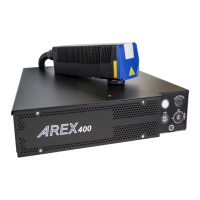Absorption of laser radiation
User Manual 95
Absorption of laser radiation
Human tissues absorbs electromagnetic radiation in different ways depending
on tissue characteristics and the wavelength of the radiation. Certain wave-
lengths may be transmitted or absorbed, in different levels, by the human tissue.
I
n the specific case of the eye, the Cornea and Crystalline lens allows most of the
radiation within the wavelength range of 400nm to 1400nm to pass a reach the
retina (where are the vision sensors). This range includes the visible light as
wells a s near-infrared. The Arex™ 400 laser markers emit in the 1060nm range
and thus can be focalized by the eye lens at retina with serious risk of causing
irreversible damage do vision sensors.
Regarding human skin, the tissue abortion lev
el is higher for the same wave-
length range but the maximum exposure tolerance level, before there is a dam-
age, is different compared to eye.
Retina
Vitreus Body Cornea
Optical Nerve Crystalline Lens Crystalline Humor
Figure 1: Eyeball section.
The damage mechanism, that absorbed laser radiation can cause, depends on
the radiation wavelength. Radiation on the short wavelength range (UV 180-
400nm) generally cause photochemical effects such as:
• cataract, or opacification of the crystalline lens
• melanin coloring, or reddening of the skin
Radiation at longer wavelength range (IR 7
80nm to 10µm), generally cause ther-
mal effects such as:
• detachment or photocoagulation of the retina
• burning of the tissue
The degree of injury depends on the amount of absorbed radiation; the power,
en
ergy and peak power of the radiation source, as well as the time exposed to
such radiation.

